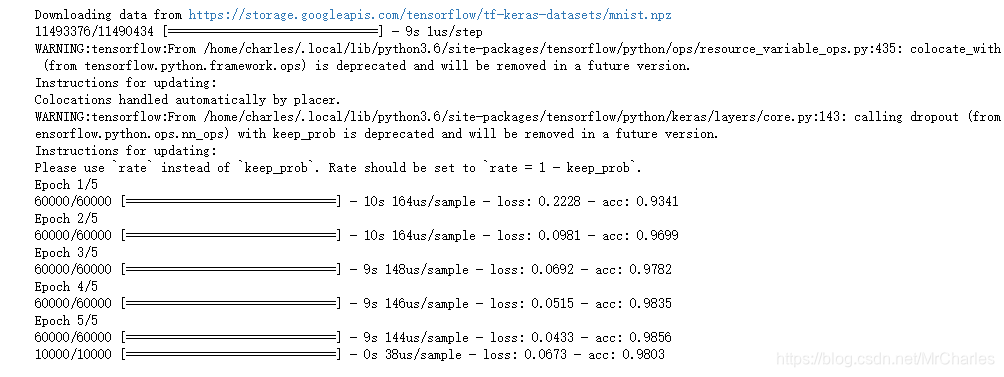kaggle 实战 (2): CNN 手写数字识别
文章目录
Tensorflow 官方示例
import tensorflow as tf
mnist = tf.keras.datasets.mnist
(x_train, y_train),(x_test, y_test) = mnist.load_data()
x_train, x_test = x_train / 255.0, x_test / 255.0
model = tf.keras.models.Sequential([
tf.keras.layers.Flatten(input_shape=(28, 28)),
tf.keras.layers.Dense(512, activation=tf.nn.relu),
tf.keras.layers.Dropout(0.2),
tf.keras.layers.Dense(10, activation=tf.nn.softmax)
])
model.compile(optimizer='adam',
loss='sparse_categorical_crossentropy',
metrics=['accuracy'])
model.fit(x_train, y_train, epochs=5)
model.evaluate(x_test, y_test)

这个本身精度不高,我们可以改变结构提升精度
CNN
from __future__ import division, print_function, absolute_import
# Import MNIST data
from tensorflow.examples.tutorials.mnist import input_data
mnist = input_data.read_data_sets("/tmp/data/", one_hot=False)
import tensorflow as tf
import matplotlib.pyplot as plt
import numpy as np
# Training Parameters
learning_rate = 0.001
num_steps = 2000
batch_size = 128
# Network Parameters
num_input = 784 # MNIST data input (img shape: 28*28)
num_classes = 10 # MNIST total classes (0-9 digits)
dropout = 0.25 # Dropout, probability to drop a unit
# Create the neural network
def conv_net(x_dict, n_classes, dropout, reuse, is_training):
# Define a scope for reusing the variables
with tf.variable_scope('ConvNet', reuse=reuse):
# TF Estimator input is a dict, in case of multiple inputs
x = x_dict['images']
# MNIST data input is a 1-D vector of 784 features (28*28 pixels)
# Reshape to match picture format [Height x Width x Channel]
# Tensor input become 4-D: [Batch Size, Height, Width, Channel]
x = tf.reshape(x, shape=[-1, 28, 28, 1])
# Convolution Layer with 32 filters and a kernel size of 5
conv1 = tf.layers.conv2d(x, 32, 5, activation=tf.nn.relu)
# Max Pooling (down-sampling) with strides of 2 and kernel size of 2
conv1 = tf.layers.max_pooling2d(conv1, 2, 2)
# Convolution Layer with 64 filters and a kernel size of 3
conv2 = tf.layers.conv2d(conv1, 64, 3, activation=tf.nn.relu)
# Max Pooling (down-sampling) with strides of 2 and kernel size of 2
conv2 = tf.layers.max_pooling2d(conv2, 2, 2)
# Flatten the data to a 1-D vector for the fully connected layer
fc1 = tf.contrib.layers.flatten(conv2)
# Fully connected layer (in tf contrib folder for now)
fc1 = tf.layers.dense(fc1, 1024)
# Apply Dropout (if is_training is False, dropout is not applied)
fc1 = tf.layers.dropout(fc1, rate=dropout, training=is_training)
# Output layer, class prediction
out = tf.layers.dense(fc1, n_classes)
return out
# Define the model function (following TF Estimator Template)
def model_fn(features, labels, mode):
# Build the neural network
# Because Dropout have different behavior at training and prediction time, we
# need to create 2 distinct computation graphs that still share the same weights.
logits_train = conv_net(features, num_classes, dropout, reuse=False, is_training=True)
logits_test = conv_net(features, num_classes, dropout, reuse=True, is_training=False)
# Predictions
pred_classes = tf.argmax(logits_test, axis=1)
pred_probas = tf.nn.softmax(logits_test)
# If prediction mode, early return
if mode == tf.estimator.ModeKeys.PREDICT:
return tf.estimator.EstimatorSpec(mode, predictions=pred_classes)
# Define loss and optimizer
loss_op = tf.reduce_mean(tf.nn.sparse_softmax_cross_entropy_with_logits(
logits=logits_train, labels=tf.cast(labels, dtype=tf.int32)))
optimizer = tf.train.AdamOptimizer(learning_rate=learning_rate)
train_op = optimizer.minimize(loss_op, global_step=tf.train.get_global_step())
# Evaluate the accuracy of the model
acc_op = tf.metrics.accuracy(labels=labels, predictions=pred_classes)
# TF Estimators requires to return a EstimatorSpec, that specify
# the different ops for training, evaluating, ...
estim_specs = tf.estimator.EstimatorSpec(
mode=mode,
predictions=pred_classes,
loss=loss_op,
train_op=train_op,
eval_metric_ops={'accuracy': acc_op})
return estim_specs
# Build the Estimator
model = tf.estimator.Estimator(model_fn)
# Define the input function for training
input_fn = tf.estimator.inputs.numpy_input_fn(
x={'images': mnist.train.images}, y=mnist.train.labels,
batch_size=batch_size, num_epochs=None, shuffle=True)
# Train the Model
model.train(input_fn, steps=num_steps)
# Evaluate the Model
# Define the input function for evaluating
input_fn = tf.estimator.inputs.numpy_input_fn(
x={'images': mnist.test.images}, y=mnist.test.labels,
batch_size=batch_size, shuffle=False)
# Use the Estimator 'evaluate' method
model.evaluate(input_fn)
import pandas as pd # data processing, CSV file I/O (e.g. pd.read_csv)
#test=pd.read_csv('./input/test.csv')
import numpy
from numpy import genfromtxt
my_data = numpy.double(genfromtxt('./input/test.csv', delimiter=','))
# Prepare the input data
input_fn = tf.estimator.inputs.numpy_input_fn(
x={'images': numpy.float32(my_data[1:,:])}, shuffle=False)
# Use the model to predict the images class
preds2 = list(model.predict(input_fn))
Submission = pd.DataFrame({
"ImageId": range(1, len(preds2)+1),
"Label": preds2
})
Submission.to_csv("cnnMnistSubmission.csv", index=False)
Submission.head(5)
提交结果

kaggle 实战 (2): CNN 手写数字识别的更多相关文章
- Kaggle竞赛丨入门手写数字识别之KNN、CNN、降维
引言 这段时间来,看了西瓜书.蓝皮书,各种机器学习算法都有所了解,但在实践方面却缺乏相应的锻炼.于是我决定通过Kaggle这个平台来提升一下自己的应用能力,培养自己的数据分析能力. 我个人的计划是先从 ...
- CNN 手写数字识别
1. 知识点准备 在了解 CNN 网络神经之前有两个概念要理解,第一是二维图像上卷积的概念,第二是 pooling 的概念. a. 卷积 关于卷积的概念和细节可以参考这里,卷积运算有两个非常重要特性, ...
- 卷积神经网络CNN 手写数字识别
1. 知识点准备 在了解 CNN 网络神经之前有两个概念要理解,第一是二维图像上卷积的概念,第二是 pooling 的概念. a. 卷积 关于卷积的概念和细节可以参考这里,卷积运算有两个非常重要特性, ...
- Keras cnn 手写数字识别示例
#基于mnist数据集的手写数字识别 #构造了cnn网络拟合识别函数,前两层为卷积层,第三层为池化层,第四层为Flatten层,最后两层为全连接层 #基于Keras 2.1.1 Tensorflow ...
- pytorch CNN 手写数字识别
一个被放弃的入门级的例子终于被我实现了,虽然还不太完美,但还是想记录下 1.预处理 相比较从库里下载数据集(关键是经常失败,格式也看不懂),更喜欢直接拿图片,从网上找了半天,最后从CSDN上下载了一个 ...
- keras框架的CNN手写数字识别MNIST
参考:林大贵.TensorFlow+Keras深度学习人工智能实践应用[M].北京:清华大学出版社,2018. 首先在命令行中写入 activate tensorflow和jupyter notebo ...
- kaggle 实战 (1): PCA + KNN 手写数字识别
文章目录 加载package read data PCA 降维探索 选择50维度, 拆分数据为训练集,测试机 KNN PCA降维和K值筛选 分析k & 维度 vs 精度 预测 生成提交文件 本 ...
- 深度学习之PyTorch实战(3)——实战手写数字识别
上一节,我们已经学会了基于PyTorch深度学习框架高效,快捷的搭建一个神经网络,并对模型进行训练和对参数进行优化的方法,接下来让我们牛刀小试,基于PyTorch框架使用神经网络来解决一个关于手写数字 ...
- keras和tensorflow搭建DNN、CNN、RNN手写数字识别
MNIST手写数字集 MNIST是一个由美国由美国邮政系统开发的手写数字识别数据集.手写内容是0~9,一共有60000个图片样本,我们可以到MNIST官网免费下载,总共4个.gz后缀的压缩文件,该文件 ...
随机推荐
- HBase 永久RIT(Region-In-Transition)问题
HBase 永久RIT(Region-In-Transition)问题:异常关机导致HBase表损坏和丢失,大量Regions 处于Offline状态,无法上线. 问题1:启动HBase时,HBase ...
- jQuery 实现复选框全选、反选及获取选中的值
实现复选框全选,反选及获取选中的值: 代码如下: <!doctype html> <html lang="en"> <head> <met ...
- hbase启动的时候报:cat: /home/hadoop/hbase-0.94.6-cdh4.5.0/target/cached_classpath.txt: 没有那个文件或目录
启动hbase的时候: -cdh4.5.0/bin$ hbase shell cat: /home/hadoop/hbase--cdh4.5.0/target/cached_classpath.txt ...
- hdu6537 /// DP 最长不降子序列->最长公共子序列
题目大意: 给定一个字符串 字符为0~9 求翻转某个区间后使得串中的最长不降子序列最长 因为字符范围为0~9 假设有一个 0 1 2 3 4 5 6 7 8 9 的序列 此时翻转某个区间得到形如 0 ...
- dubbo源码学习(二) : spring 自定义标签
做dubbo的配置时很容易发现,dubbo有一套自己的标签,提供给开发者配置,其实每一个标签对应着一个 实体,在容器启动的时候,dubbo会对所有的配置进行解析然后将解析后的内容设置到实体里,最终du ...
- WXML 数据绑定
- PushSharp 由于远程方已关闭传输流,身份验证失败。
前段时间用到了PushSharp给APNS发推送,但是用的时候遇见很诡异的事情,每次第一次运行的时候能成功发送到 但是接下来就无限的提示“由于远程方已关闭传输流,身份验证失败. “ 然后我就各种找原因 ...
- Sql Server 小知识不断扩充中
1. char.varchar.nvarchar 区别 char 定长字符数据长度8000字符,小于8000字符时以空格填充. varchar 变长字符数据最大长度8000,小于8000字符时不会以 ...
- Python中的网络爬虫怎么用?
爬虫概述 (约2016年)网络爬虫个人使用和科研范畴基本不存在问题,但商业盈利范畴就要看对方了. 通过网站的Robots协议(爬虫协议)可以知道可以和不可以抓取的内容,其中User-Agent: 为允 ...
- Jenkins配置gitlab
一.免密公钥登陆1 登陆gitlab 搜ssh Keys 2 添加在Jenkins 服务器本地创建好的公钥 保存完成 也可以手动添加 到/var/opt/gitlab/.ssh/authorized_ ...
